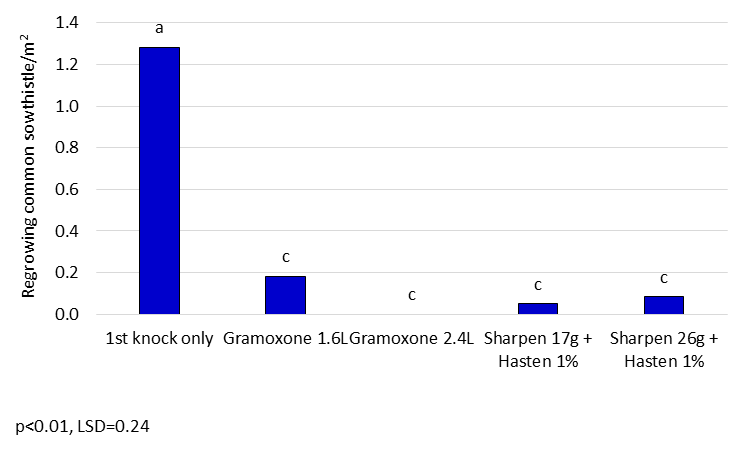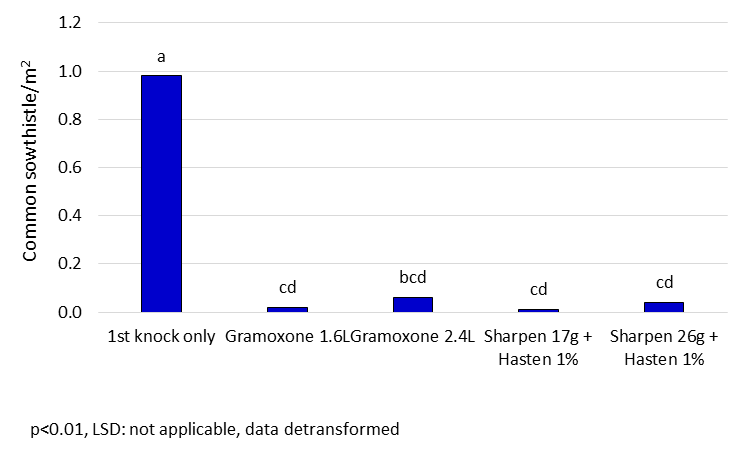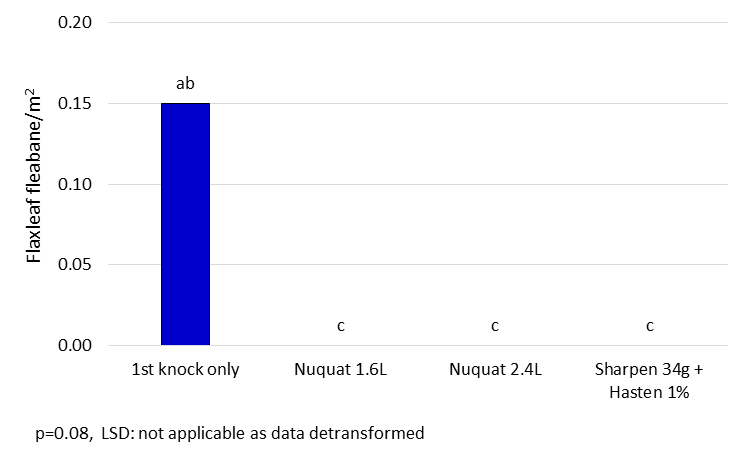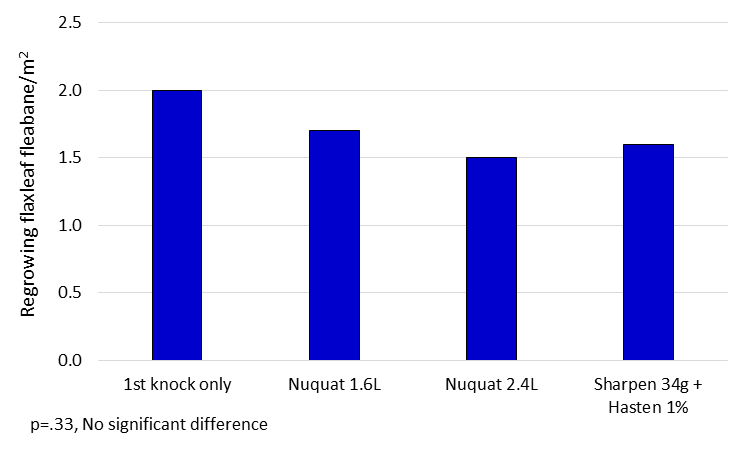Alternate second knock herbicides for broadleaf weeds in fallow – are there other options?
Author: Richard Daniel, Anthony Mitchell, Linda Bailey, Denielle Kilby and Branko Duric (Northern Grower Alliance) | Date: 28 Feb 2018
Take home messages
- A series of 8 trials has shown that saflufenacil (Sharpen®) may have a useful role as a 2nd knock treatment for key broadleaf weeds.
- Level of control was at least equivalent to paraquat at 1.6-2.4L/ha of the 250 g ai/L formulation in these trials.
- However poor control was achieved from both paraquat and saflufenacil when used as 2nd knock treatments on flaxleaf fleabane, following glyphosate only.
- No option provided effective management when applied as a 2nd knock on tall fleabane (Conyza sumatrensis).
- Paraquat did not provide acceptable levels of suppression of Canadian fleabane (Conyza canadensis) when applied as a 2nd knock at 1.6-2.4L/ha.
- Mixtures of saflufenacil and paraquat require further evaluation as they may provide more robust control of key fallow weeds.
Background
The sequential application of two separate herbicide treatments has become the most common ‘double knock’ approach used in weed management. Unfortunately these approaches have added cost, complexity and scheduling issues to weed management programs but have been required for two main reasons:
- To control herbicide resistant weed populations, that may have been selected by prolonged use of similar mode of action chemistry; and
- Control of weed species or stages that are unsuccessfully controlled with single herbicide applications.
Paraquat has been the key active ingredient used in the second knock situation and can provide effective management of a wide range of grass and broadleaf weeds. However, it is clear we require other options to use in this management window to:
- Avoid the more rapid selection of paraquat resistance; and
- Provide options that may improve weed control in situations where paraquat efficacy is not adequate.
Since winter 2016, NGA have been screening a range of herbicides, to identify options that have potential for this use pattern. The two key broadleaf weeds being targeted are common sowthistle (Sonchus oleraceus) and flaxleaf fleabane (Conyza bonariensis).
Trials conducted
Table 1 shows the key details of trials conducted during the last 12-15 months.
Table 1. Trial details
Main Weed | Location | Date of 1st knock application | Days to 2nd knock application |
|---|---|---|---|
Common sowthistle | Tambar Springs | 9/10/2016 | 7 |
Flaxleaf fleabane | Mt Tyson | 17/10/2016 | 11 |
Flaxleaf fleabane | Dalby | 6/12/2016 | 10 |
Common sowthistle | Moree | 16/6/2017 | 19 |
Common sowthistle | Mullaley | 20/9/2017 | 14 |
Tall fleabane | St Ruth | 27/11/2017 | 9 |
Canadian fleabane | Cecil Plains | 27/11/2017 | 10 |
Common sowthistle | Somerton | 19/12/2017 | 8 |
NB Tall fleabane - Conyza sumatrensis, Canadian fleabane - Conyza canadensis
Approach
1st knock treatments were applied uniformly across the entire trial area. The most common treatment was a mixture of glyphosate and 2,4D amine, with the rates varying with the weed stage, environmental conditions and the grower/adviser recommendations.
2nd knock applications were applied between 7 and 19 days after the 1st knock treatments.
- All trials included a range of rates of paraquat for benchmarking purposes.
- Initial trials included a range of group G herbicides (all registered in fallow alone or in mixture with glyphosate or paraquat) and the group N herbicide glufosinate (Basta®).
- The most promising group G option was evaluated in all trials.
- The ‘untreated’ plots in all trials had the 1st knock herbicide treatment applied but did not receive a 2nd knock application.
- Trials in 2016 on both common sowthistle and flaxleaf fleabane showed improved efficacy from saflufenacil (Sharpen) as a 2nd knock treatment compared to flumioxazin (Valor®) or carfentrazone (eg Nail®). No further evaluation has been conducted on flumioxazin or carfentrazone.
- Interestingly, the performance of saflufenacil has appeared more consistent when used in a 2nd knock application, particularly on common sowthistle.
- Glufosinate was evaluated in the initial series of trials but did not provide any consistent benefit over paraquat or saflufenacil. Performance of glufosinate has appeared similar whether used in a 1st or 2nd knock situation (data not presented).
Results to date
Figures 1 and 2 show results from two of the trials evaluating double knock control of common sowthistle conducted in 2017.
 Figure 1. 2nd knock control of common sowthistle (26 days after application) at Mullaley Oct 2017
Figure 1. 2nd knock control of common sowthistle (26 days after application) at Mullaley Oct 2017
NB 1st knock application was Glyphosate 450 + Amicide® 625

Figure 2. 2nd knock control of common sowthistle (44 days after application)
at Croppa Creek Aug 2017
NB 1st knock application was Glyphosate CT + Amicide 625
Figures 3 and 4 show results from the two sites in 2016 evaluating double knock control of flaxleaf fleabane. NB Figure 4 shows the result from a site where the commercial application of a 1st knock was glyphosate alone. Previous activity has shown that the addition of 2,4D to the first spray is generally critical to achieve effective control of flaxleaf fleabane, even when double knocked with paraquat.
 Figure 3. 2nd knock control of flaxleaf fleabane (24 days after application) at Dalby Jan 2017
Figure 3. 2nd knock control of flaxleaf fleabane (24 days after application) at Dalby Jan 2017
NB 1st knock application was Glyphosate 450 + Amicide 720, significant differences are only tested at the 10% level
 Figure 4. 2nd knock control of flaxleaf fleabane (17 days after application)
Figure 4. 2nd knock control of flaxleaf fleabane (17 days after application)
at Mt Tyson Nov 2016
NB 1st knock application was Glyphosate CT only
Key points
- Sharpen (700g/kg saflufenacil) at rates of 17 and 26g/ha provided a similar level of control to paraquat at 1.6 to 2.4L/ha when applied as a 2nd knock application on common sowthistle in all 4 trials.
- Sharpen (700g/kg saflufenacil) at rates of 34g/ha provided equivalent control to paraquat at 1.6 to 2.4L/ha when applied as a 2nd knock application on flaxleaf fleabane in 2 trials.
- Poor levels of control were achieved by all 2nd knock options on flaxleaf fleabane when glyphosate only was used as the 1st knock (see Figure 4).
- No herbicide product provided useful levels of control of tall fleabane (Conyza sumatrensis) when applied following Roundup Ultra® Max and Amicide 625 (data not presented).
- Paraquat did not provide useful levels of control of Canadian fleabane (Conyza canadensis) when applied following Tordon™ 75D (data not presented)
Conclusions
The results to date indicate that the group G active ingredient saflufenacil warrants further investigation as a potential 2nd knock option for the control of a number of key broadleaf weed species. Across this series of trials, the level of control was similar to that provided by rates of paraquat of 1.6-2.4L/ha. However in situations where paraquat failed to provide useful efficacy on flaxleaf fleabane following an application of glyphosate only, there was no indication of improved benefit from saflufenacil.
Where to next?
Saflufenacil clearly may have a useful fit as a 2nd knock alternative on broadleaf weeds such as common sowthistle or flaxleaf fleabane. However the majority of fallow applications have a need for both broadleaf and grass control. Consequently part of the project activity in 2017 was to commence an evaluation of the fit of saflufenacil/paraquat mixtures to identify cost effective but more robust options for use as 2nd knocks.
Acknowledgements
The research undertaken as part of this project is made possible by the significant contributions of growers through both trial cooperation and the support of the GRDC, the author would like to thank them for their continued support.
NGA would particularly like to acknowledge the assistance from our trial co-operators during this series of trials: Terry Leerentveld, Justin Commens, Warren Myring, Ben McIntyre, Aaron Goddard, Gavin Maguire, Graeme Gall and the Strang Family.
Contact details
Richard Daniel
Northern Grower Alliance
Ph: 07 4639 5344
Email: richard.daniel@nga.org.au
® Registered trademark
™ Trademark
GRDC Project Code: NGA00004,
Was this page helpful?
YOUR FEEDBACK
